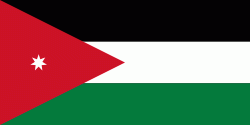Zarqa Governorate (Muḩāfaz̧at az Zarqā’)
Zarqa Governorate (محافظة الزرقاء Muħāfazat az-Zarqāʔ, local dialects ez-Zergā or ez-Zer'a) is the third largest governorate in Jordan by population. The capital of Zarqa governorate is Zarqa City, which is the largest city in the governorate. It is located 25 km east of the Jordanian capital Amman. The second largest city in the governorate is Russeifa.
Zarqa Governorate hosts the largest military and air bases of the Jordanian armed forces.
The land of Zarqa Governorate has been inhabited since the Bronze Age, most prominent were the Ammonite kingdom and the Nabateans, who constructed the fort known as Qasr al Hallabat, which then was used as a fort by the Romans, and then as a desert palace by the Umayyads.
The most significant historical remains are the Umayyad desert palaces, such as Qasr Amra, a World Heritage site, Qasr al Hallabat, Qasr Shabib in the center of the city of Zarqa, as well as the Castle of Azraq.
After the construction of the Hedjaz railway by the Ottoman Turks at the beginning of the 1900s, Zarqa became a strategically important hub that connects Damascus to Medina, the cities along the railway started flourishing. Later, Jordan's Arab Legion led by Glubb Pasha had its main bases in Zarqa.
Zarqa Governorate hosts the largest military and air bases of the Jordanian armed forces.
The land of Zarqa Governorate has been inhabited since the Bronze Age, most prominent were the Ammonite kingdom and the Nabateans, who constructed the fort known as Qasr al Hallabat, which then was used as a fort by the Romans, and then as a desert palace by the Umayyads.
The most significant historical remains are the Umayyad desert palaces, such as Qasr Amra, a World Heritage site, Qasr al Hallabat, Qasr Shabib in the center of the city of Zarqa, as well as the Castle of Azraq.
After the construction of the Hedjaz railway by the Ottoman Turks at the beginning of the 1900s, Zarqa became a strategically important hub that connects Damascus to Medina, the cities along the railway started flourishing. Later, Jordan's Arab Legion led by Glubb Pasha had its main bases in Zarqa.
Map - Zarqa Governorate (Muḩāfaz̧at az Zarqā’)
Map
Country - Jordan
 |
 |
| Flag of Jordan | |
Modern-day Jordan has been inhabited by humans since the Paleolithic period. Three stable kingdoms emerged there at the end of the Bronze Age: Ammon, Moab and Edom. In the third century BC, the Arab Nabataeans established their Kingdom with Petra as the capital. Later rulers of the Transjordan region include the Assyrian, Babylonian, Roman, Byzantine, Rashidun, Umayyad, Abbasid, and the Ottoman empires. After the Great Arab Revolt against the Ottomans in 1916 during World War I, the Greater Syria region was partitioned by Britain and France. The Emirate of Transjordan was established in 1921 by the Hashemite, then Emir, Abdullah I, and the emirate became a British protectorate. In 1946, Jordan gained independence and became officially known in Arabic as the Hashemite Kingdom of Jordan. The country captured the West Bank during the 1948 Arab–Israeli War and annexed it until it was lost to Israel in 1967. Jordan renounced its claim to the territory in 1988, and became the second Arab state to sign a peace treaty with Israel in 1994.
Currency / Language
| ISO | Currency | Symbol | Significant figures |
|---|---|---|---|
| JOD | Jordanian dinar | دا | 3 |
| ISO | Language |
|---|---|
| AR | Arabic language |
| EN | English language |
















